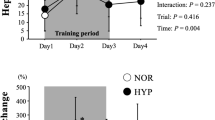Abstract
To establish whether or not hypoxia influences the training-induced adaptation of hormonal responses to exercise, 21 healthy, untrained subjects [26 (2) years, mean (SE)] were studied in three groups before and after 5 weeks' training (cycle ergometer, 45 min· day−1, 5 days· week−1). Group 1 trained at sea level at 70% maximal oxygen uptake (\(\dot V\)O2max), group 2 in a hypobaric chamber at a simulated altitude of 2500 m at 70% of altitude\(\dot V\)O2max, and group 3 at a simulated altitude of 2500 m at the same absolute work rate as group 1. Arterial blood was sampled before, during and at the end of exhaustive cycling at sea level (85% of pretraining of\(\dot V\)O2max).\(\dot V\)O2 increased by 12 (2)% with no significant difference between groups, whereas endurance improved most in group 1 (P < 0.05). Training-induced changes in response to exercise of noradrenaline, adrenaline, growth hormone, β-endorphin, glucagon, and insulin were similar in the three groups. Concentrations of erythropoietin and 2,3-diphosphoglycerate at rest did not change over the training period. In conclusion, within 5 weeks of training, no further adaptation of hormonal exercise responses takes place if intensity is increased above 70%\(\dot V\)O2max. Furthermore, hypoxia per se does not add to the training-induced hormonal responses to exercise.
Similar content being viewed by others
References
Bach FW, Fahrenkrug J, Jensen K, Dahlstrøm G, Ekman R (1987) Plasma β-endorphin during clinical and experimental ischaemic pain. Scand J Clin Lab Invest 47:751–758
Ben-Jonathan N, Porter JC (1976) A sensitive radioenzymatic assay for dopamine, norepinephrine and epinephrine in plasma and tissue. Endocrinology 98:1497–1507
Boutellier U, Büchel R, Kundert A, Sprengler C (1992) The respiratory system as an exercise limiting factor in normal trained subjects. Eur J Appl Physiol 65:347–353
Eckardt KU, Boutellier U, Kurtz A, Schopen M, Koller EA, Bauer C (1989) Rate of erythropoietin formation in humans in response to acute hypobaric hypoxia. J Appl Physiol 66:1785–1788
Galbo H (1983) Hormonal and metabolic adaptation to exercise. Thieme, Stuttgart
Galbo H, Holst JJ, Christensen NJ (1979) The effect of different diets and of insulin on the hormonal response to prolonged exercise. Acta Physiol Scand 107:19–32
Galbo H, Christensen NJ, Mikines KJ, Sonne B, Hilsted J, Hagen C, Fahrenkrug J (1981) The effect of fasting on the hormonal response to graded exercise. J Clin Endocrinol Metab 52:1106–1112
Jelkmann W (1992) Erythropoietin: structure, control of production, and function. Physiol Rev 72:449–489
Kjær M, Bangsbo J, Lortie G, Galbo H (1988) Hormonal response to exercise in humans: influence of hypoxia and physical training. Am J Physiol 254: R197-R203
Klausen K, Ghisler U, Mohr T, Fogh-Andersen N (1992) Erythropoietin, 2,3 diphosphoglycerate and plasma volume during moderate-altitude training. Scand J Med Sci Sports 2:16–20
Levine BD, Friedman DB, Engfred K, Hanel B, Kjær M, Clifford PS, Secher NH (1992) The effect of normoxic or hypobaric hypoxic endurance training on the hypoxic ventilatory response. Med Sci Sports Exerc 24:769–775
Nielsen OJ (1988) Determination of human erythropoietin by radioimmunoassay: method and clinical data. Clin Chim Acta 176:303–314
Rørth M (1974) Hypoxia, red cell oxygen affinity and erythropoietin production. Clin Haematol 3:595–607
Schmidt W, Dahners HW, Correa R, Ramirez R, Rojas J, Böning D (1990) Blood gas transport properties in endurance-training athletes living at different altitudes. Int J Sports Med 11:15–21
Schmidt W, Eckardt KU, Hilgendorf A, Strauch S, Bauer C (1991) Effects of maximal and submaximal exercise under normoxic and hypoxic conditions on serum erythropoietin level. Int J Sports Med 12:457–461
Schwandt HJ, Heyduck B, Gunga HC, Röcker L (1991) Influence of prolonged physical exercise on the erythropoietin concentration in blood. Eur J Appl Physiol 63:463–466
Siegel S, Castellan HJ (1988) Non-parametric statistics for the behavioral sciences. McGraw-Hill, New York
Siri WE, Dyke CD van, Winchell HS, Pollycove M, Parker HG, Cleveland AS (1966) Early erythropoietin, blood, and physiological responses to severe hypoxia in man. J Appl Physiol 21:73–80
Snedecor GW, Cochran WG (1965) Statistical methods. Iowa State University Press, Ames
Sutton JR (1977) Effect of acute hypoxia on the hormonal response to exercise. J Appl Physiol 42:587–592
Winder WW, Hagberg JM, Hickson RC, Ehsani AA, McLane JA (1978) Time course of sympatho-adrenal adaptation to endurance exercise training. J Appl Physiol 45:370–374
Author information
Authors and Affiliations
Rights and permissions
About this article
Cite this article
Engfred, K., Kjær, M., Secher, N.H. et al. Hypoxia and training-induced adaptation of hormonal responses to exercise in humans. Europ. J. Appl. Physiol. 68, 303–309 (1994). https://doi.org/10.1007/BF00571448
Accepted:
Issue Date:
DOI: https://doi.org/10.1007/BF00571448




